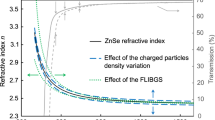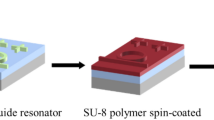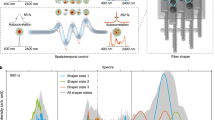Abstract
We propose and demonstrate an all-optical wavelength routing approach that uses a tuning mechanism based upon the optical gradient force in a specially designed nano-optomechanical system. The resulting mechanically compliant ‘spiderweb’ resonator realizes seamless wavelength routing over a range of 3,000 times the intrinsic channel width, with a tuning efficiency of 309 GHz mW−1, a switching time of less than 200 ns, and 100% channel quality preservation over the entire tuning range. These results indicate the potential for radiation pressure actuated devices to be used in a variety of photonics applications, such as channel routing/switching, buffering, dispersion compensation, pulse trapping/release and widely tunable lasers.
This is a preview of subscription content, access via your institution
Access options
Subscribe to this journal
Receive 12 print issues and online access
$209.00 per year
only $17.42 per issue
Buy this article
- Purchase on Springer Link
- Instant access to full article PDF
Prices may be subject to local taxes which are calculated during checkout




Similar content being viewed by others
References
Beausoleil, R., Kuekes, P., Snider, G., Wang, S. & Williams, R. Nanoelectronic and nanophotonic interconnect. Proc. IEEE 96, 230–247 (2008).
Berthold, J., Saleh, A., Blair, L. & Simmons, J. Optical networking: past, present, and future. J. Lightwave Technol. 26, 1104–1118 (2008).
Gripp, J. et al. Optical switch fabrics for ultra-high-capacity IP routers. J. Lightwave Technol. 21, 2839–2850 (2003).
Strand, J. & Chiu, A. Realizing the advantages of optical reconfigurability and restoration with integrated optical cross-connects. J. Lightwave Technol. 21, 2871–2882 (2003).
Neilson, D., Doerr, C., Marom, D., Ryf, R. & Earnshaw, M. Wavelength selective switching for optical bandwidth management. Bell Labs Tech. J. 11, 105–128 (2006).
Sadot, D. & Boimovich, E. Tunable optical filters for dense WDM networks. IEEE Commun. Mag. 36, 50–55 (1998).
Eldada, L. Optical communication components. Rev. Sci. Instrum. 75, 575 (2004).
Tomlinson, W. Evolution of passive optical component technologies for fiber-optic communication systems. J. Lightwave Technol. 26, 1046–1063 (2008).
Little, B. et al. Ultra-compact Si-SiO2 microring resonator optical channel dropping filters. IEEE Photon. Technol. Lett. 10, 549–551 (1998).
Yi, Y. et al. Tunable multichannel optical filter based on silicon photonic band gap materials actuation. Appl. Phys. Lett. 81, 4112–4114 (2002).
Rabiei, P. & Steier, W. Tunable polymer double micro-ring filters. IEEE Photon. Technol. Lett. 15, 1255–1257 (2003).
Asano, T., Kunishi, W., Nakamura, M., Song, B. & Noda, S. Dynamic wavelength tuning of channel-drop device in two-dimensional photonic crystal slab. Electron. Lett. 41, 37–38 (2005).
Poon, J. et al. Wide-range tuning of polymer microring resonators by the photobleaching of CLD-1 chromophores. Opt. Lett. 29, 2584–2586 (2004).
Xu, Q., Schmidt, B., Pradhan, S. & Lipson, M. Micrometre-scale silicon electro-optic modulator. Nature 435, 325–327 (2005).
Ilchenko, V. & Matsko, A. Optical resonators with whispering-gallery modes — Part II: applications. IEEE J. Sel. Top. Quantum Electron. 12, 15–32 (2006).
Wu, M., Solgaard, O. & Ford, J. Optical MEMS for lightwave communication. J. Lightwave Technol. 24, 4433–4454 (2006).
Monat, C., Domachuk, P. & Eggleton, B. Integrated optofluidics: a new river of light. Nature Photon. 1, 106–114 (2007).
Xia, F., Rooks, M., Sekaric, L. & Vlasov, Y. Ultra-compact high order ring resonator filters using submicron silicon photonic wires for on-chip optical interconnects. Opt. Express 15, 11934–11941 (2007).
Sherwood-Droz, N. et al. Optical 4 × 4 hitless slicon router for optical networks-on-chip (NoC). Opt. Express 16, 15915–15922 (2008).
Vlasov, Y., Green, W. & Xia, F. High-throughput silicon nanophotonic wavelength-insensitive switch for on-chip optical networks. Nature Photon. 2, 242–246 (2008).
Fushman, I. et al. Ultrafast nonlinear optical tuning of photonic crystal cavities. Appl. Phys. Lett. 90, 091118 (2007).
Yano, M., Yamagishi, F. & Tsuda, T. Optical MEMS for photonic switching-compact and stable optical crossconnect switches for simple, fast, and flexible wavelength applications in recent photonic networks. IEEE J. Sel. Top. Quantum Electron. 11, 383–394 (2005).
Braginskii˘, V. B. & Manukin, A. B. Measurement of Weak Forces in Physics Experiments (University of Chicago Press, 1977).
Dorsel, A., McCullen, J., Meystre, P., Vignes, E. & Walther, H. Optical bistability and mirror confinement induced by radiation pressure. Phys. Rev. Lett. 51, 1550–1553 (1983).
Kippenberg, T. J., Rokhsari, H., Carmon, T., Scherer, A. & Vahala, K. J. Analysis of radiation-pressure induced mechanical oscillation of an optical microcavity. Phys. Rev. Lett. 95, 033901 (2005).
Gigan, S. et al. Self-cooling of a micromirror by radiation pressure. Nature 444, 67–70 (2006).
Arcizet, O., Cohadon, P.-F., Briant, T., Pinard, M. & Heidmann, A. Radiation-pressure cooling and optomechanical instability of a micromirror. Nature 444, 71–73 (2006).
Kleckner, D. & Bouwmeester, D. Sub-kelvin optical cooling of a micromechanical resonator. Nature 444, 75–78 (2006).
Thompson, J. et al. Strong dispersive coupling of a high-finesse cavity to a micromechanical membrane. Nature 452, 72–75 (2008).
Li, M. et al. Harnessing optical forces in integrated photonic circuits. Nature 456, 480–484 (2008).
Eichenfield, M., Camacho, R., Chan, J., Vahala, K. J. & Painter, O. A picogram- and nanometre-scale photonic crystal optomechanical cavity. Nature 459, 550–555 (2009).
Anetsberger, G. et al. Near-field cavity optomechanics with nanomechanical oscillators. <http:arXiv:0904.4051v1> (2009).
Lin, Q., Rosenberg, J., Jiang, X., Vahala, K. J. & Painter, O. Mechanical oscillation and cooling actuated by the optical gradient force. <http:arXiv:0905.2716v1> (2009).
Abramovici, A. et al. Ligo: the laser interferometer gravitational-wave observatory. Science 256, 325 (1992).
Braginskii˘, V. B., Khalili, F. Y. & Thorne, K. S. Quantum Measurement (Cambridge Univ. Press, 1992).
Eichenfield, M. & Painter, O. J. Optomechanics of strongly coupled stacked monolithic microdisks. In Conference on Lasers and Electro-Optics/Quantum Electronics and Laser Science Conference and Photonic Applications Systems Technologies, JMD1 (OSA, 2008).
Wiederhecker, G. S., Chen, L., Gonarenko, A. & Lipson, M. Controlling photonic structures using optical forces. <http:arXiv:0904.0794v1> (2009).
Povinelli, M. L. et al. Evanescent-wave bonding between optical waveguides. Opt. Lett. 30, 3042–3044 (2005).
Rakich, P., Popović, M., Soljaaˇić, M. & Ippen, E. Trapping, corralling and spectral bonding of optical resonances through optically induced potentials. Nature Photon. 1, 658–665 (2007).
Anetsberger, G., Riviere, R., Schliesser, A., Arcizet, O. & Kippenberg, T. J. Ultralow-dissipation optomechanical resonators on a chip. Nature Photon. 2, 627–633 (2008).
Seeds, A. & Williams, K. Microwave photonics. J. Lightwave Technol. 24, 4628–4641 (2006).
Kippenberg, T. & Vahala, K. Cavity opto-mechanics. Opt. Express 15, 17172–17205 (2007).
Favero, I. & Karrai, K. Optomechanics of deformable optical cavities. Nature Photon. 3, 201–205 (2009).
Bao, M. & Yang, H. Squeeze film air damping in MEMS. Sens. Actuators A 136, 3–27 (2007).
Agrawal, G. P. Nonlinear Fiber Optics 4th ed (Academic Press, 2007).
DelHaye, P. et al. Optical frequency comb generation from a monolithic microresonator. Nature 450, 1214–1217 (2007).
Ferrera, M. et al. Low-power continuous-wave nonlinear optics in doped silica glass integrated waveguide structures. Nature Photon. 2, 737–740 (2008).
Fontaine, N. et al. Continuously tunable optical buffering at 40 Gb/s for optical packet switching networks. J. Lightwave Technol. 26, 3776–3783 (2008).
Madsen, C. et al. Integrated all-pass filters for tunable dispersion and dispersion slope compensation. IEEE Photon. Technol. Lett. 11, 1623–1625 (1999).
Huang, M., Zhou, Y. & Chang-Hasnain, C. A nanoelectromechanical tunable laser. Nature Photon. 2, 180–184 (2008).
Acknowledgements
Funding for this work was provided by a DARPA seedling effort managed by Prof. Henryk Temkin, and the DARPA Phaser program.
Author information
Authors and Affiliations
Contributions
J.R. and Q.L. performed the design, fabrication and testing of devices. All authors contributed to planning the measurements and writing the manuscript.
Corresponding authors
Supplementary information
Rights and permissions
About this article
Cite this article
Rosenberg, J., Lin, Q. & Painter, O. Static and dynamic wavelength routing via the gradient optical force. Nature Photon 3, 478–483 (2009). https://doi.org/10.1038/nphoton.2009.137
Received:
Accepted:
Published:
Issue Date:
DOI: https://doi.org/10.1038/nphoton.2009.137
This article is cited by
-
Optomechanical coupling behavior of multilayer nano-waveguides
Archive of Applied Mechanics (2023)
-
Thermodynamic optical pressures in tight-binding nonlinear multimode photonic systems
Communications Physics (2022)
-
Microwave photonic circulator based on optomechanical-like interactions
Quantum Information Processing (2021)
-
Non-Markovian Effect in Optomechanical System
International Journal of Theoretical Physics (2018)
-
Generalized non-reciprocity in an optomechanical circuit via synthetic magnetism and reservoir engineering
Nature Physics (2017)



